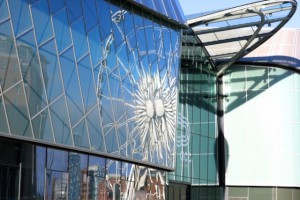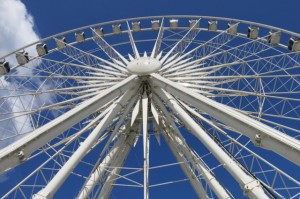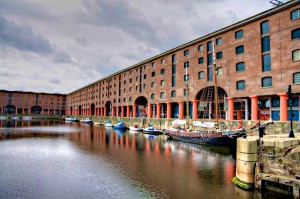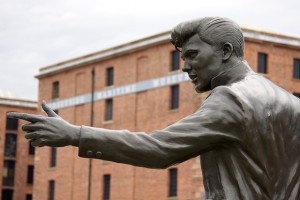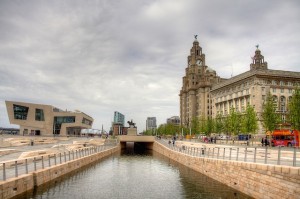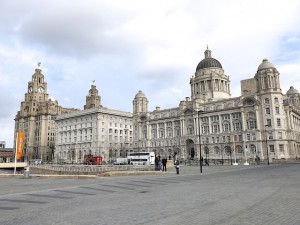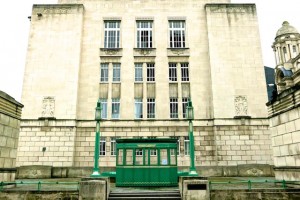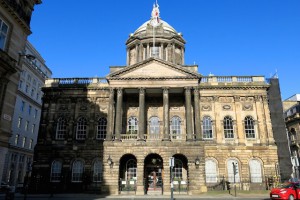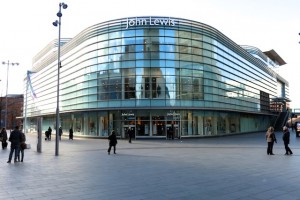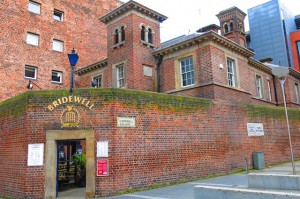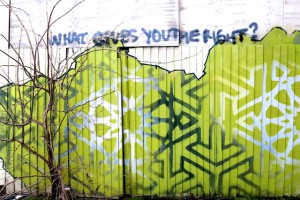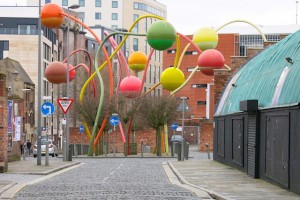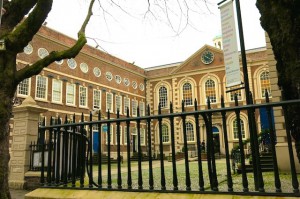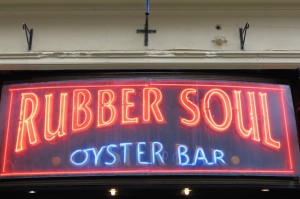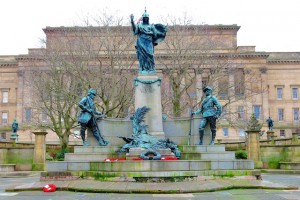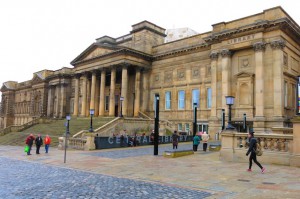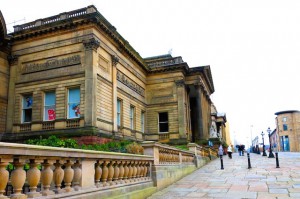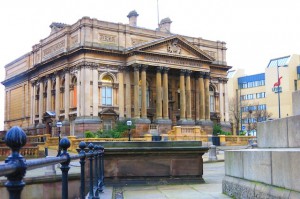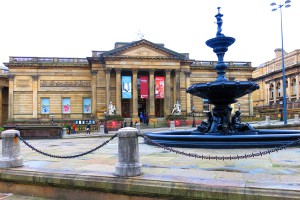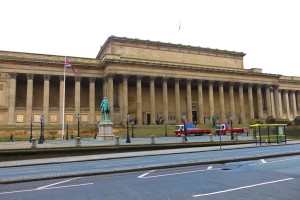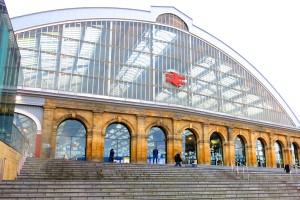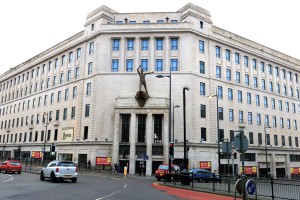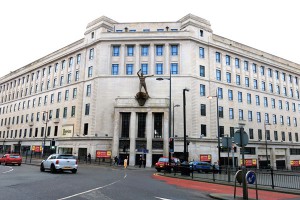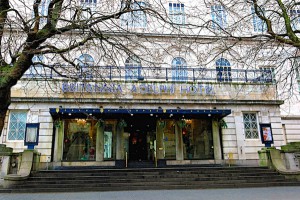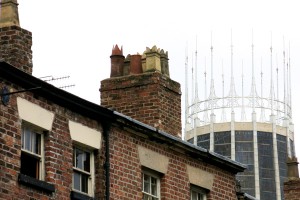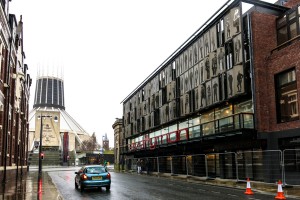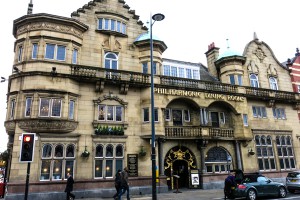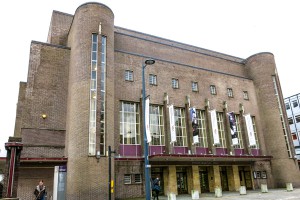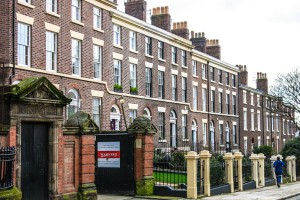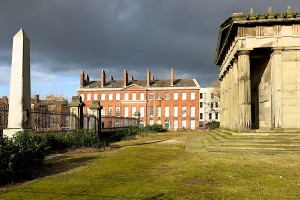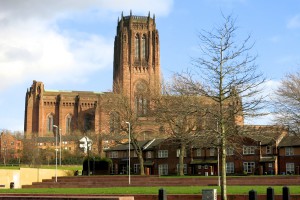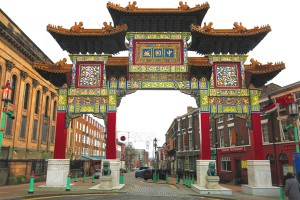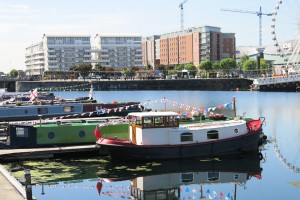Superlative Walks
Urban and rural trails, each with something very specialLIVERPOOL WALK – DIRECTIONS AND ADDED INFORMATION
It is possible to start this walk from any point on the route. Those arriving by public transport may wish to begin at Lime Street Station. There are car parks all around the City, mostly reasonably priced and well signed. I suggest a start from the “Waterfront” multi-storey car park near to the Echo Arena.
- Leaving the car park via one of the doors on its Western side, nearest to the River, turn right and walk past the Convention Centre and the Echo Arena towards the big wheel.
More information
The Arena and Convention Centre Liverpool, opened in 2008, is a multipurpose venue built on the former Kings Dock. The ACC has the 11,000-seat Echo Arena and the BT Convention Centre.
- Pass the big wheel to the left, down some very shallow, irregular steps. And beware.
More information
- Cross the narrow dock and head straight for the centre of the Albert Dock’s Britannia Pavilion. Enter through the double glass doors, just to the right of “The Beatles Story.”
Inside the Albert Dock, either walk all the way round or turn left and go clockwise, right at the first corner and then along the long unbroken Western side, past the Tate Gallery.
More information
Albert Dock (1846) has the largest group of Grade I listed buildings in the UK. With no structural wood, it was the first non-combustible warehouse system in the world. The Dock became a popular store for valuable cargoes such as brandy, cotton, tea, silk, tobacco and sugar. However, new shipping technology meant that, within 50 years, larger, more open docks were required. During World War II, it was used by the British Atlantic Fleet. Financial problems and a decline of docking in the city led to closure in 1972. Redevelopment began in 1981and the Albert Dock was officially re-opened in 1984. The Tate Liverpool, designed by James Sterling opened in 1988.
- At the far end of the Dock, go as straight on as it is possible to do, past the statue of Billy Fury and cross the bridge over the lock gate.
More information
Billy Fury (1940 – 1983), was an internationally successful singer from the late-1950s to the mid-1960s.] He equalled The Beatles‘ record of 24 hits in the 1960s. His most successful songs were “Halfway to Paradise” and “Jealousy.” The £44,000 bronze statue was unveiled in the Museum of Liverpool Life in 2003. The statue was moved to its present location in 2007,
5. Walk towards the large rectangular window of the Museum of Liverpool and past its left side, with great views across the Mersey to Birkenhead.
More information
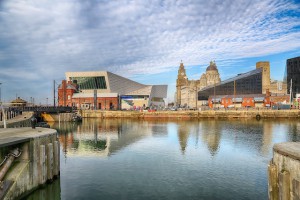 The Museum of Liverpool is part of a development which has been dogged by controversy. It opened in 2011 and was swiftly nominated for the “Carbuncle Cup,” given annually by the magazine Building Design to “the ugliest building in the UK, completed in the last 12 months”.
The Museum of Liverpool is part of a development which has been dogged by controversy. It opened in 2011 and was swiftly nominated for the “Carbuncle Cup,” given annually by the magazine Building Design to “the ugliest building in the UK, completed in the last 12 months”.
The three blocks at Mann Island, with 400 flats above ground-level shops and galleries attracted similar derision. The wedge-shaped black granite constructions were nominated for the Carbuncle Cup a year after their neighbour. Neither of these Liverpool buildings won the Cup. The 2011 award went to Media City, Salford and the 2012 winner was the Cutty Sark Renovation in Greenwich. But Liverpool had won the Cup in 2009, with the Ferry Terminal Building.
6. Once past the Museum, you will see ahead and slightly to the right, a new stretch of canal and, over to the left, the Cup-winning Ferry Terminal Building.
More information
In 1846 the Leeds and Liverpool Canal was directly linked to the docks via the Stanley Dock Branch. Georges Dock was filled-in at the beginning of the 20th Century to allow the building of the Three Graces. Boats wishing to travel from the North Docks to the South Docks then had to go via the River Mersey. Following a £22 million facelift, the new canal link opened to boats in April 2009.
7. Walk along the side of the canal, taking care on more irregular, modern steps, towards the Three Graces.
More information
The first of the Three Graces, the Port of Liverpool Building, has a Baroque style using Portland stone. It is said that its central dome was based on an unused plan for the city’s Anglican Cathedral. It was built on land reclaimed from George’s Dock, in 1903-7.
In 1913 the Cunard shipping line built its new headquarters, The Cunard Building, using reinforced concrete, clad in Portland Stone, in a style intended to recall grand Italian palaces.
The 1911 Royal Liver Building was the tallest office building in the country and one of the first in the world to use steel-reinforced concrete. The sheet copper Liver Birds look in opposite directions. Reputedly, the female looks over the sea, watching for sailors’ safe return, while the male looks over the city, to check the pubs are still open.
- Take Brunswick Street, between the Port of Liverpool and Cunard Buildings and pass, on your right, the Mersey Tunnel Building with its green Mersey Tunnel kiosk. Cross the main road and on the far side turn left and then turn right up Water Street.
More information
Oriel Chambers, on the left of Water Street, was built in 1864, with a revolutionary design by Peter Ellis (no relation) – an iron frame supporting large glass panes, to maximise natural light. It had few fans (one critic described it as “a great abortion”) but is now a Grade I listed barristers’ chambers.
At the top of the street is the Town Hall, initially built in 1754. Rebuilt after a fire in 1795, the dome was completed in 1802 and the portico in 1811. The space beneath was intended for election hustings. There was an unsuccessful attempt by “Fenians” to blow-up the building in 1881. Bombs did damage it in the Liverpool Blitz of 1941 but the damage was repaired after the war.
- At the top of Water Street, with the Town Hall on the left, turn right down Castle Street. Carry straight on where it becomes pedestrianised.
More information
Near the top of Castle Street, on the left, is a red brick, sandstone and terracotta building for the British and Foreign Marine Insurance Company, completed in 1890. Castle Street leads to Derby Square, formerly the site of Liverpool Castle, which overlooked the traditional pool, the original harbour for the City, long since filled-in. The Castle was built in the early 13th century. Demolition began in the Civil War and the job was completed in the 1720s.
10. At Derby Square turn left down Lord Street. After crossing to the right side of the street carry straight on where it becomes pedestrianised. Turn right into Paradise Street.
More information
Previously known as The Paradise Project, Liverpool ONE opened in 2008, as the largest open air shopping centre in the United Kingdom and the 10th largest overall.
- After passing the John Lewis Department Store, cross Hanover Street at the pedestrian crossing, then turn left into Argyle Street.
More information
12. Turn left into Campbell Street and then almost immediately right into Henry Street.
13. Turn left into York Street then first right into Duke Street, the main Ropewalks thoroughfare
- Continue along Duke Street then turn left into Colquitt Street then left again into Parr Street. After crossing Suffolk Street, the road widens at Wolstenholme Square.
More information
The Square became the home for Cream in the 1990s. establishing Liverpool’s reputation for clubbing. Cuban sculptor Jorge Pardo created “Penelope” for the 2006 Biennial. In Homer’s Odyssey, Penelope was Ulysses’ wife, who faithfully awaited her husband’s return from the Trojan war, deterring numerous suitors by saying she had to finish weaving a robe, unravelling her work each night to maintain her work-in-progress and hence her fidelity. The stalks refer to both Penelope’s weaving and to the local history of rope-making.
15. Leave the Square at the far end, Gradwell Street. Turn right into Hanover Street. Cross the road and take the second left into School Lane.
More information
On the left, the Bluecoat Chambers (formerly the Blue Coat School) is Liverpool’s oldest surviving building, built in 1716 by Bryan Blundell, a sea captain, as a charity school for over 100 poor children. The school moved to Wavertree in 1906. Lord Leverhulme bought and saved the building. The Bluecoat is now a creative “hub.”
16. At the end of School Lane, turn right into Paradise Street, which soon becomes Whitechapel. After crossing the Church Street/Lord Street junction, turn left into Button Street, immediately right and then left into Matthew Street.
More information
Matthew Street was the location of the Cavern Club, where The Beatles played on numerous occasions in their early career. The original Club opened in 1957, closed in March 1973 and was filled-in during construction work on the Merseyrail underground rail loop. The Cavern was rebuilt with similar arches and tunnels across the street from the site of the original club.
The psychiatrist and psychotherapist Carl Jung is often cited as visiting Liverpool in 1927, but only recorded a dream in which he had, and of which he wrote “Liverpool is the pool of life, it makes to live.” A statue of Jung was erected in Mathew Street in 1987.
- At the top of Matthew Street, under the statue of John Lennon high on the left, turn right into North John Street and then almost immediately right again into Victoria Street. After about 500 metres approach the group of magnificent buildings on either side of William Brown Street. Cross the road and enter the St John’s Gardens.
More information
18. Leave St John’s Gardens at the top left corner, to the rear of St George’s Hall and cross William Brown Street. Walk down to the left to visit the Liverpool Central Library.
More information
The Library’s £55m refurbishment was completed in 2013. The developer inserted a new five-storey building, with reading and information floors, café, meeting rooms, atrium and roof terrace. The modern section is well linked to the Grade II listed Picton Reading Room (completed in 1879, emulating the British Museum Reading Room, a circular room with 30-metre high bookshelves.)
- Continue up William Brown Street. The next major building is the Walker Art Gallery.
More information
20. Moving up William Brown Street, the next major building is the County Sessions House.
More information
21. Cross the top of William Brown Street and walk across the open space, at the Centre of which is the Wellington Column.
More information
This monument was completed in 1863, eleven years after the Duke died, funds having been slow to come forward. £1000 was later donated to the city to build in 1879 the nearby cast-iron Steble Fountain, after locals protested about the rubbish-strewn state of the site. The water pressure was very low so the fountain was linked to a steam pump in nearby St George’s Hall, but judges ordered it to be turned off as the pulsating water disrupted court proceedings.
22. Leave the Column and walk right to the steps and pillars at the front of St George’s Hall.
More information
Pevsner described St George’s Hall as one of the finest neo-Grecian buildings in the world. Opened in 1854, it originally combined of law courts and an entertainment venue. In 1840, the plans were superimposed on top of rival buildings, including St Paul’s Cathedral and Birmingham Town Hall, to check that it would be bigger. The hall reopened in 2007 after a £23m restoration. It now has a Heritage Centre which is open six days a week and provides access to the Great Hall (from a viewing balcony), cells, courts, a small shop and cafe.
23. Cross the road (Lime Street) to Lime Street Station.
More information
The original Lime Street Station was completed in 1837. In 1867 the present northern arched train shed was added. With a span of 200-foot, it was the largest in the world. The station is elegantly fronted by the former North Western Hotel. Designed by Alfred Waterhouse, the 1879 building is now accommodation for students of Liverpool John Moores University.
24. At the foot of the station steps turn right along Lime Street (or left if you are starting the walk here and have come out of the station) and enter Renshaw Street.
More information
At the junction of Renshaw Street and Ranelagh Street are two fine buildings: to the right, Lewis’s Department store and to the left the Adelphi Hotel.
The original Lewis’s store was built in 1910-13 and destroyed in the 1941 blitz. The current building was designed in 1947, in Portland stone with red granite columns. The corner has a large bronze statue by Jacob Epstein (1954-6) and three panels showing scenes of childhood. The store closed in 2010.
The current Adelphi building (1911-4), was regarded as the country’s most luxurious hotel outside London. The Adelphi served as the most popular hotel for wealthy passengers before they embarked on their journey to North America.
25. After passing the Adelphi on your left cross the foot of Brownlow Hill and bear left up Mount Pleasant.
More information
At the junction of Renshaw Street and Ranelagh Street are two fine buildings: to the right, Lewis’s Department store and to the left the Adelphi Hotel.
On the right is the red brick and stone former University Club. Opposite is what Pevsner describes as a “tatty glazed triangular block” linked with a “brutal multi-storey car park.” Fair comment.
About 500 metres up the hill, just after passing John Moores University’s “John Lennon Art and Design Building, in Great Orford Street on the left, you will arrive at the magnificent Roman Catholic Metropolitan Cathedral, set back on the left.
26. Turn left to visit the Catholic Cathedral up the grand modern staircase.
More information
This modernist building departs from the usual linear style of cathedrals with its circular shape. Work began on Sir Edward Lutyens’ elaborate design for the cathedral in 1933. He intended it to build the second largest church in the world, but spiralling costs caused his project to be abandoned, with only the crypt built. Sir Frederick Gibberd finished the job in 1962-7 with a simpler scheme. Sadly, the cathedral suffered problems almost as soon as it opened, such as a leaking roof and crumbling mosaics. The entrance steps were finished in 2003.
27. Cross Hope Street to walk along the right-hand side of Hope Street, passing the Everyman Theatre on the left.
More information
28. Continue along Hope Street to the Philharmonic Hotel, on the right just before the junction with Hardman Street.
More Information
The Art Nouveau Philharmonic was built in 1900 for the brewer Robert Cain. Cain aimed to “so beautify the public houses under his control that they would be an ornament to the town of his birth.” The interior has fine wooden panels, stained glass windows and copper and plasterwork panels. The gents toilets have ornate pink granite and colourful tiles. A sign outside warns that ladies may be present. Sadly, the ladies loos aren’t a patch on their male counterparts.
29. Turn right out of the Philharmonic and cross Hardman Street to continue along the right side of Hope Street.
More Information
On the left is the Philharmonic Hall, home to the Royal Liverpool Philharmonic Orchestra. This 1937 Art Deco building has a cinema screen that can be raised up from the floor, reflecting its origins. Construction was delayed when Liverpool Corporation refused to back a building suitable only as a concert hall. They demanded an auditorium equally suited to cinema and theatre use.
30. Turn right into Hope Place.
More Information
Hope Place has fine terraced houses. On the right, the Unity Theatre was formed as the Merseyside Left Theatre in the 1930s. The company staged classics alongside contemporary left wing works. It occupies a former synagogue from 1857 with a modern extension built in 1997.
31. At the bottom of Hope Place turn left into Pilgrim Street. At the end of Pilgrim Street, cross the road (Upper Duke Street) and turn right along its far side towards the Anglican Cathedral entrance.
More Information
32. Past the Oratory turn left and walk up to the Cathedral entrance.
More Information
This sandstone cathedral may look old but was completed in 1978, 74 years after work first began. Until his death in 1960, architect Sir Giles Gilbert Scott continued to tinker with the design. The completed church is nothing like the original plan yet is surprisingly simple, the soaring, vaulted ceilings creating a genuine sense of awe. At 189 metres, it is the longest cathedral in the world.
- Leaving the Cathedral, turn left down Upper Duke Street. At the junction with Great George Street, cross the road to the left and walk under the Chinese Arch.
More Information
Liverpool’s Chinatown is home to the oldest Chinese community in Europe. The arch at the gateway is the largest, multiple-span arch of its kind outside of China. Planning for the arch began in 1992 as part of a regeneration scheme. Designs were chosen by the local Chinese community. Construction began in October 1999 with the arrival of 20 craftsmen from Liverpool’s twin city of Shanghai. 2000 block components manufactured there were shipped to Liverpool. Work finished in just 90 days and was officially opened on Chinese New Year in 2000 at a final cost of £ 700,000.
34. Walk down Nelson Street through Great George Square.
More Information
This was laid out in 1803 and built up to 1836. It was Liverpool’s grandest residential square but, after bombing in 1941, only a few 19th century houses remain.
35. Turn right into St James Street and continue as it becomes Park Lane.
More Information
- At the end of Park Lane, turn left into Liver Street which leads to the main Waterfront Road, opposite the Albert Dock. Cross the road and return to the starting position.

